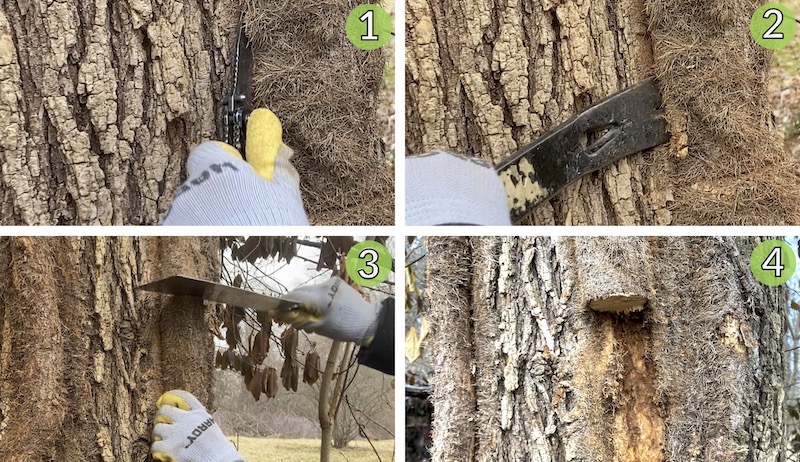
How to get rid of Virginia creeper (native) and invasive vines like euonymus (wintercreeper) and English ivy is important as these vines can be devastating when allowed to climb high onto trees. “If they get established and get big, as they often do, they can cover the whole tree and then rob the tree of nutrients and sunlight,” says Emily Mayo, executive assistant and member of the Nashville Tree Conservation Corps.
“The vines are competing for the things that the tree needs to survive. That’s, ultimately, what kills the tree.”
Fortunately, winter is a great time to rid your trees of choking vines. “Winter is my favorite time partly because there are no chiggers,” Mayo laughs. With the leaves off of the trees—and because many invasive vines remain leafy year-round—visibility is better now, too.
Read more: Poison ivy and other opportunists are on the rise.
The Right Stuff
In part, how you’ll tackle problem vines on your own trees depends on the vines’ ages and sizes. For how to get rid of Virginia creeper vines that are only about the diameter of a pencil or smaller, you can usually pull these away from a tree without damaging its bark. But for a much larger vine, Mayo cautions, “You don’t want to pull it off of the tree, because it can take the bark with it and then open the tree up to disease.”
If you have just a few young vines to snip off, a good set of pruning shears will do. But for bigger jobs, you’ll need some extra equipment, including:
- a sharp knife
- small pry bar
- hammer or mallet (optional)
- small handsaw
You might also want to wear a pair of gloves, long pants and long sleeves—especially if you’re removing poison ivy. “Some people have a reaction to English ivy as well,” Mayo notes.
Step by Step
Because large, thick vines likely will have had many years to integrate themselves with their host tree, removing them can take real patience. What follows are instructions for freeing a tree from the grip of some very well-established vines. (See numbered steps in image below for reference.)
Step 1
If your vines have attached themselves to the tree’s bark via root hairs, use a sharp knife to gently cut through these on both the right and left sides of the vine.
Step 2
In the same area where you cut through the vine’s roots, carefully slide a pry bar behind the vine. You may need to use a hammer or mallet to tap the pry bar in place. Do this very gently, taking pains not to damage the tree’s bark in the process.
Slide the pry bar between the front of the tree and the back of the vine along both the left and right sides of the vine. (Ultimately, you want to isolate just enough vine segment so that you can saw through it without cutting into the tree itself.)
Step 3
Use a small handsaw to cut all the way through the vine. Be sure to stop cutting before you reach the front of the tree.
Step 4
Locate another spot along the vine that’s about 6 inches above or below the cut you just made. Repeat steps 1 through 3 in this area. Once you’ve finished cutting through the vine in this second spot, you should be able to remove a 6-inch section of vine from the tree. If you need to, you can use the pry bar to help pop out this piece of cut vine.
(Notice in the “Step 4” image that, although the tree’s bark looks discolored from long-term contact with the vine, the tree bark itself is still intact.)
“Cutting the vine basically cuts off its supply of water and nutrients from the soil and then the vine on the tree will just die and eventually fall off,” Mayo explains.
She continues, “Once you’ve got it cut off at the tree, then you can kind of pull back what’s growing from the ground.”
How to Get Rid of Virginia Creeper Vines – Extra Help
Even after you’ve cut away the vines, you should periodically check the area for any growth trying to re-sprout. And for very serious infestations of poison ivy and euonymus in particular, you might want to paint a chemical herbicide onto the cut portion of the vine stem. This will kill these plants at the root.
Rather not vanquish the vines on your own? “If it seems like a daunting task, I would definitely recommend reaching out to certified arborist to come take [vines] off the tree,” Mayo says.
To find a board-certified arborist near you, try the International Society of Arboriculture‘s online search tool.
This article about how to get rid of Virginia creeper vines was written for Hobby Farms online. Click here to subscribe to Hobby Farms print magazine.




